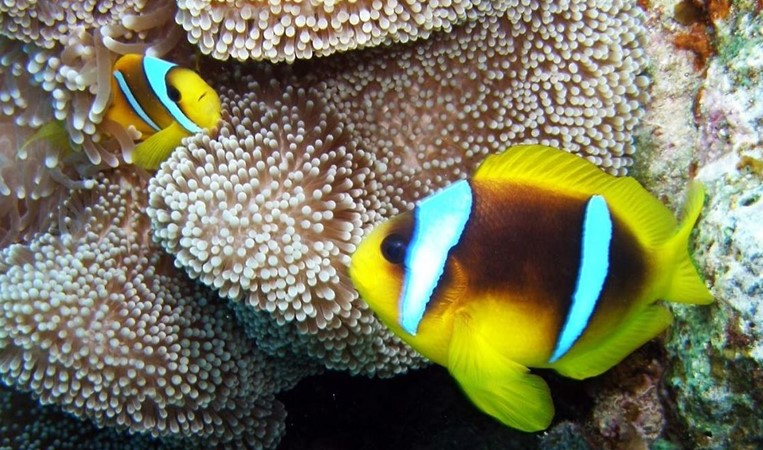Amphiprion bicinctus, meaning "both
saw-like with two stripes," commonly known as Nemo fish, is a marine fish
belonging to the family Pomacentridae, the clown fishes and damselfishes. Like
other species of the genus, the fish feeds on algae and zooplankton in the wild.
It doesn't just live in the Red Sea. You will also find it in the Gulf of Eden
and in the Chagos Islands in the Pacific, some 3364 km away. But curiously
nowhere in between.
The Red Sea Clownfish lives from the shallows down to 30 m, generally in pairs in association with an anemeone. This is a classic example of symbiosis - where two different organisms live in close physical association to the advantage of both. The stinging tentacles of the anemone protect the clownfish from predators. The benefit to the anemone is probably down to the fish's swimming within its tentacles and wafting them around, thus increasing the water flow and hence the amount of oxygen available to the anemone. The anemone may also feed on the fish's waste material, plus the fish remove bits of debris from the anemone. There is also evidence that some clownfish species attack butterfly fish, which would otherwise eat the anemone.
The clownfish are not worried by the anemone's stinging cells (nematocysts) is down to their mucus coating. When the clownfish lavae settle in the anemone their mucus coat acquires the anemone's chemical signature, which inhibits the nematocysts from firing.
Clownfish start off male, but if the female dies the dominant male will change into a female. The fish spawn around the full moon and lay 500 to 1500 eggs on a patch of cleared rock near the anemone home. The parent often rubs the anemone causing the tentacle to extend, which in turn forms a protective canopy for the eggs of the fish.
The male cares for the eggs, driving away intruders. Even divers have been attacked if they get too close. He blows water over the eggs, giving them oxygen-rich water and preventing fungus from growing over them. After around a week the eggs hatch, usually soon after sunset. The larvae then drift in the current for more than a fortnight before seeking their own anemone. A recent study found that the larvae of a similar species, the Omani clownfish, regularly travelled 400 km - the longest distance scientists have been able to track the dispersal of any coral reef fish.
The Red Sea Clownfish is known for being very active in a saltwater aquarium, which makes them attractive and a good choice for a larger display aquarium. They are generally peaceful, but grow to a large size and can become territorial when established as a mature pair. It is recommended to house Red Sea Clownfish in an aquarium with a minimum of 30 gallons of water.












 All
All
 Politics
Politics
 Economy
Economy
 Tourism
Tourism
 Nature
Nature
 Community
Community

